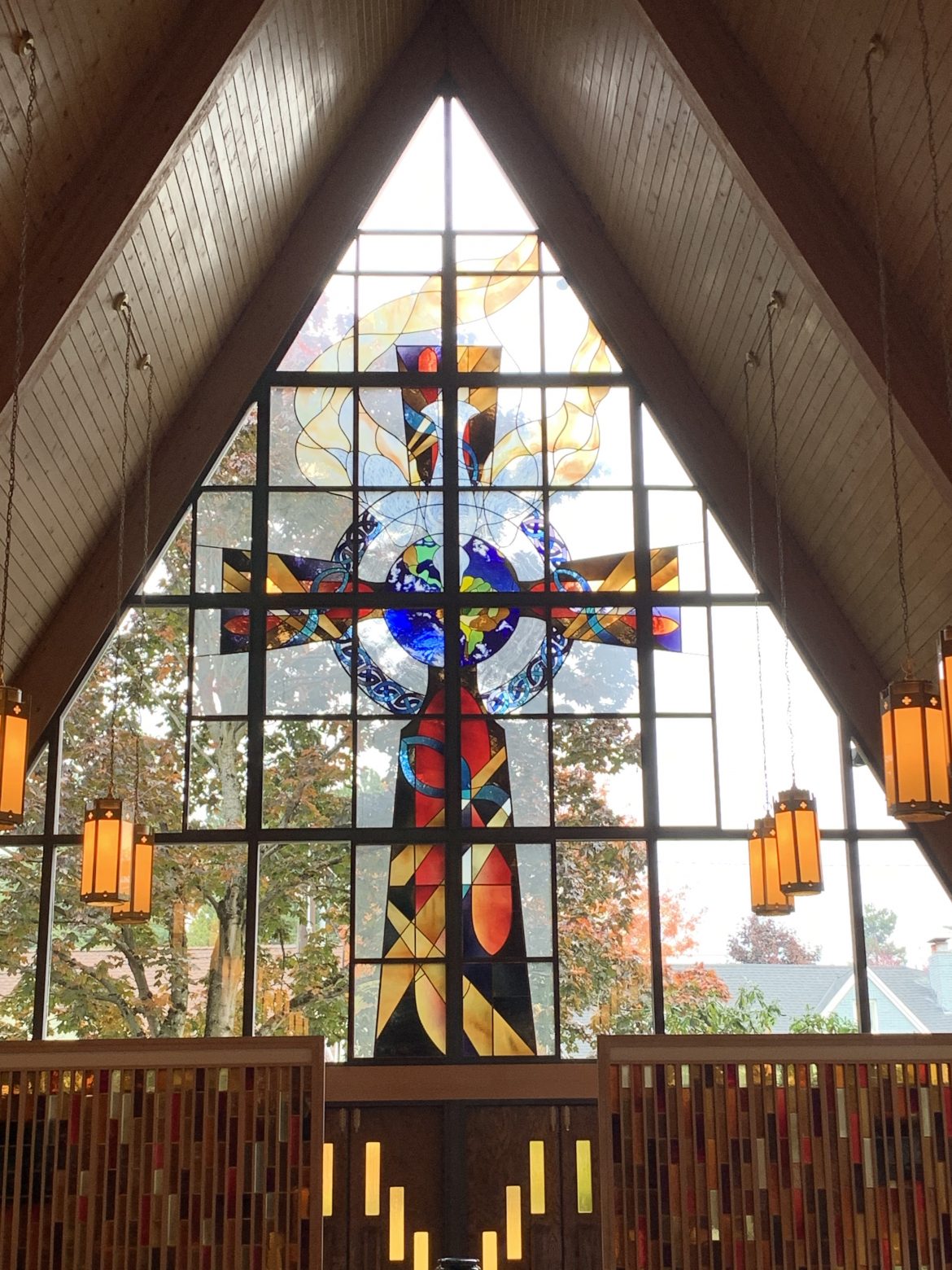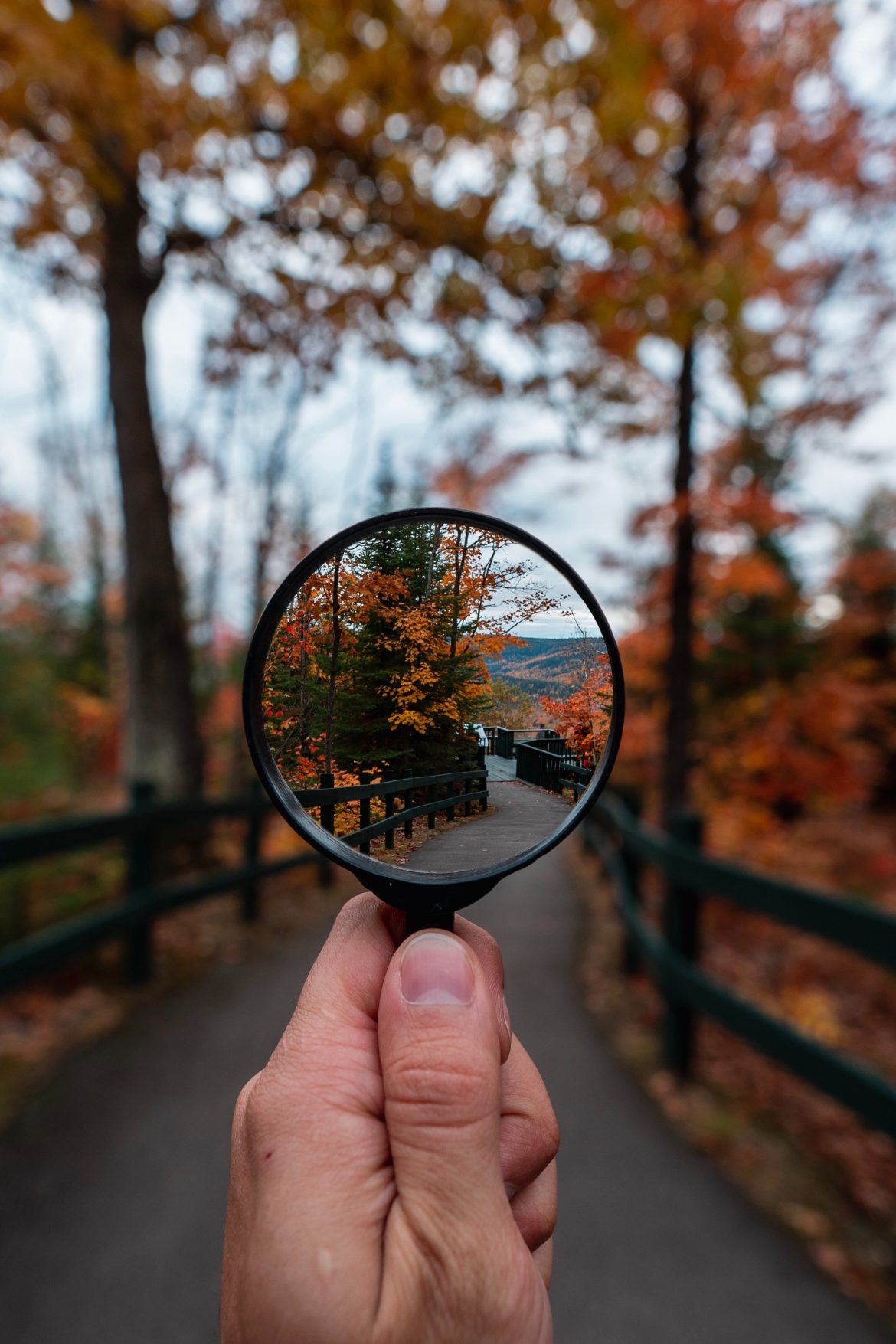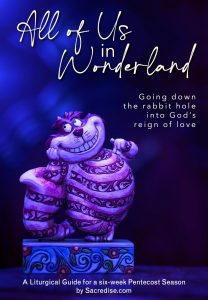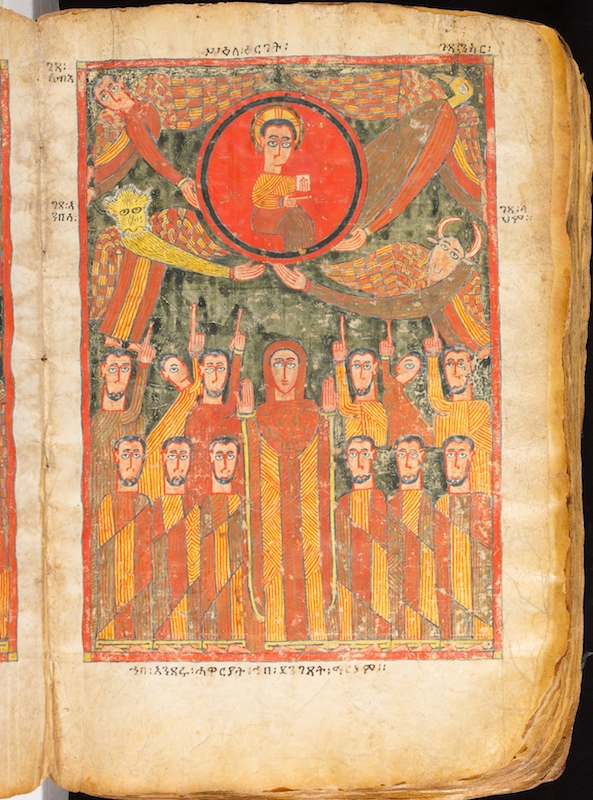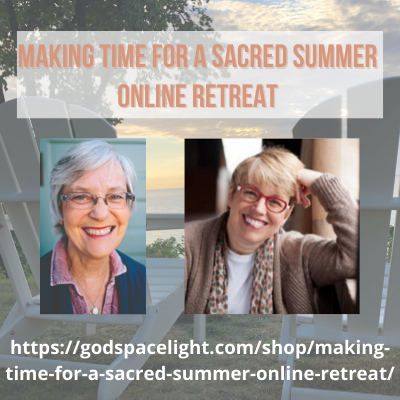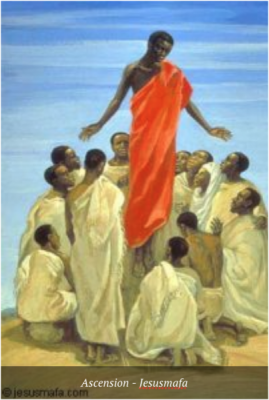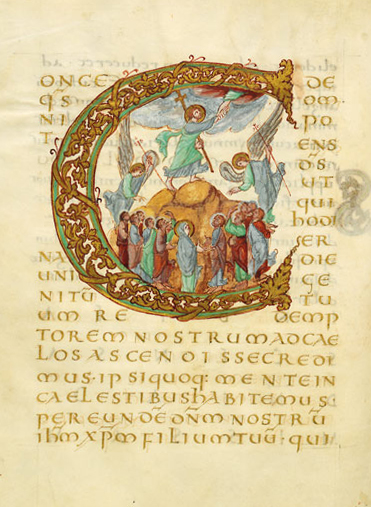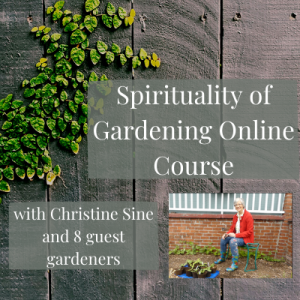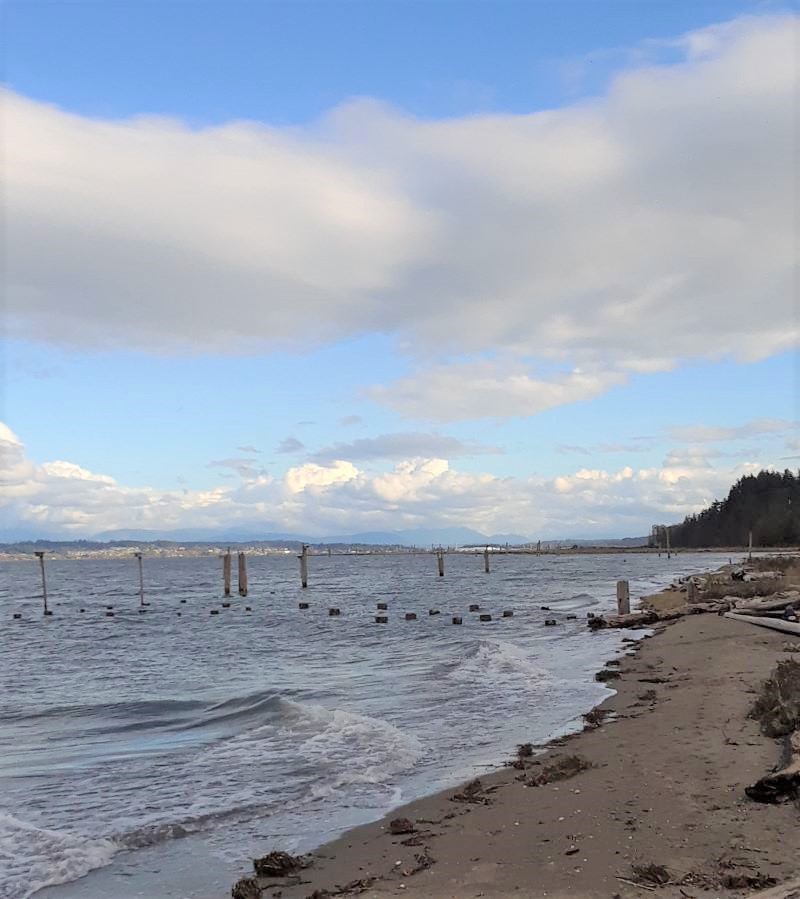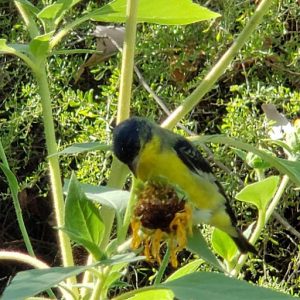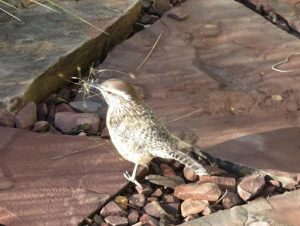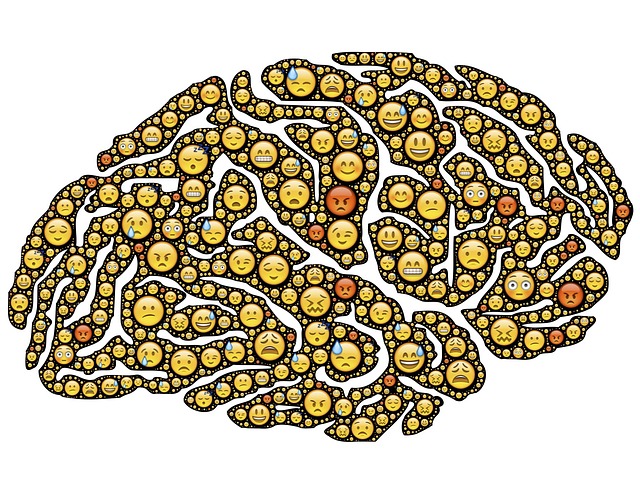Once again we are privileged be able to share the contemplative service from St Andrews episcopal Church in Seattle. Carrie Grace Littauer, prayer leader, with music by Kester Limner and Andy Myers. Permission to podcast/stream the music in this service obtained from One License with license #A-710-756
I learned about my wife’s love of flowers very early in our relationship. We were two teenagers who had only been dating for a few months when, on a trip to meet her parents, I had to cross a very busy intersection at rush hour. As we waited for our traffic light to turn green, I tried to make sense of the six or seven different roads that converged in front of me. When the light changed, I carefully eased forward, breathing a sigh of relief as we left the danger zone. But just then, Debbie shrieked, “John!” I hit the brakes, spinning around to see what terror was about to come crashing into us. Then I saw her smile as she pointed excitedly and exclaimed, “Daffodils!”
In my concentration on the cars, I had been oblivious to the flowers beside the road. Debbie couldn’t have cared less about the traffic. She was lost in the beauty of her beloved daffodils. What I saw made me tense and anxious. What Debbie saw brought her joy and relaxation. It was then that I realised: What we see and how we see determines the world in which we live.
In a few days we will celebrate Pentecost. Many of us have been taught this was the day when the Spirit was ‘poured out’ on God’s people. Before this, we are told, the Spirit was not freely available, but only ‘came on’ certain people in certain times for particular tasks. But I want to suggest another way to think about this event.
In Psalm 139, the Psalmist asks the rhetorical question, “Where can I go from your Spirit?” Then the writer goes on to celebrate that God’s Spirit is everywhere. This means that Pentecost cannot have been an outpouring of a Spirit that was previously absent from human lives. The Spirit was always present, but people were not yet aware.
In John 3:3 Jesus tells Nicodemus that no one can see God’s reign unless they are born of the Spirit. It’s significant that Jesus emphasizes seeing something to which we are otherwise blind. An experience of Spirit, a Pentecost encounter, is about having our eyes opened to a reality which was hidden to us. It is the awakening of our awareness to the presence of the Spirit and the reality of God’s reign within our ordinary human world.
To use a metaphor from Lewis Carroll’s Alice in Wonderland, Pentecost is the rabbit hole that leads us into the Wonderland of God’s reign of love. It is the moment when the Spirit draws back the veil and enables us to see God’s presence everywhere. It changes our world as we begin to grasp how the values, priorities, and purposes of God’s reign permeate every fragment of creation. And it changes how we live in that world because we cannot help but be shaped by what we see.
The Pentecost Sunday celebration is a pivot point in the Church Calendar. It’s mostly celebrated as a stand-alone event, but it marks a significant shift. This is the day we move from the first half of the year, where the focus is on Jesus’ birth, life, death and resurrection, to the second half, where we focus on how to live as Jesus did. The gift of Spirit at Pentecost is the gift of sight to see the Wonderland of God’s reign. It’s the gift of longing to see that world become a reality among us. It’s the gift of courage and strength to begin to live the way of Christ here and now. And for me, there is great value in celebrating Pentecost as a season rather than just an event.
As we open our hearts and lives to a renewed encounter with Spirit so we are taken deeper down the rabbit hole. As our sight is awakened again to the presence and activity of the Spirit within us, around us, and among us, so we are empowered a little more to collaborate with God in healing our world. And that doesn’t need just a single day. It requires months of intentional practice to allow God’s reign to become the primary reality within which we live. And that’s why I like to think of Ordinary Time as the ‘season of the Spirit’. Pentecost is simply the portal through which we enter a life shaped by the message and mission of Christ.
It’s not that the Spirit leads us out of our human world into some spiritual enclave where we can stay separate from the chaos and mess of ordinary life. It’s that we can live in the reign of God in the midst of our regular routines. We play, work, and rest as all people do. We have our homes, families, and friendships like everyone else. Like them, we vote, pay taxes, and follow the laws of our home country. But at the same time, we see the world differently, embrace different values, priorities, and purposes, and live by different ‘rules’, hopes, and dreams. As we go through our daily routines like our neighbours, our lives are shaped by eternal realities. This is what it means to live in God’s reign.
As we celebrate Pentecost this year in a world broken by war, pandemic, climate change, economic inequality, and power imbalances, may we receive again the gift of being born of the Spirit so that we may see God’s reign and embody its truth in every moment and every place.
Photo by Steven Wright on Unsplash
Editor’s Note: If you are looking for a Pentecost-and-Beyond resource, or inspired to celebrate a season of Pentecost, John van de Laar has a new resource out we’d like to highlight!
All of Us in Wonderland – Going down the rabbit hole into God’s reign of love encompasses six weeks of a season of Pentecost and is available as a personal or lay resource or a liturgical one! You can find out more by clicking here!
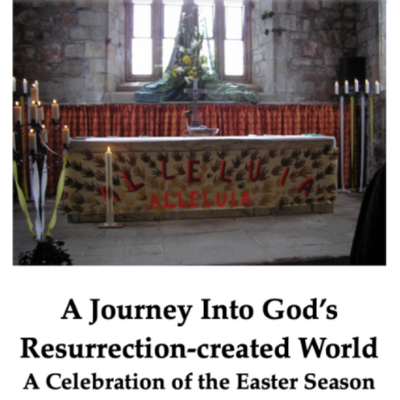 It is the Easter Season! Lasting from Easter into Pentecost, it is a time to celebrate and heal! This free download will help you find the joy in the season and includes practical suggestions for celebrating in a Covid-19 world as well.
It is the Easter Season! Lasting from Easter into Pentecost, it is a time to celebrate and heal! This free download will help you find the joy in the season and includes practical suggestions for celebrating in a Covid-19 world as well.
Yesterday was the Feast of Ascension on the Church Year Calendar. This event in the life of Jesus has been celebrated since the 4th century but many of us haven’t ever given it much thought. You can read about it in Acts 1, but this year’s lectionary finds us in the gospel of Luke and this account is much shorter.
He said to them, “This is what I told you while I was still with you: Everything must be fulfilled that is written about me in the Law of Moses, the Prophets and the Psalms.”
Then he opened their minds so they could understand the Scriptures. 46 He told them, “This is what is written: The Messiah will suffer and rise from the dead on the third day, 47 and repentance for the forgiveness of sins will be preached in his name to all nations, beginning at Jerusalem. 48 You are witnesses of these things. 49 I am going to send you what my Father has promised; but stay in the city until you have been clothed with power from on high.”
The Ascension of Jesus
50 When he had led them out to the vicinity of Bethany, he lifted up his hands and blessed them. While he was blessing them, he left them and was taken up into heaven. Then they worshiped him and returned to Jerusalem with great joy. And they stayed continually at the temple, praising God.LUKE 24: 44-53
WHAT ABOUT BLESSING?
I had never noticed the verse “He lifted up his hands and BLESSED them.” The last thing Jesus did before he physically left the planet was to BLESS his followers. He didn’t give them a big long TO-DO list, or a set of rules they should remember, but rather he gave them a blessing!
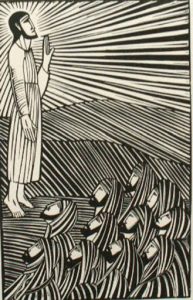
Eric Gill 1882 1940
What do you think the blessing was that Jesus gave his disciples as he ascended?
Think about what the word “Blessing” means to you. What blessing do you need from Jesus? Want do you need/want to hear from Jesus?
BLESSING. noun
noun: blessing; plural noun: blessings
God’s favor and protection.
a prayer asking for God’s favor and protection.
”a priest gave a blessing as the ship was launched”
a special favor, mercy, or benefit
Check out the different Bible verses about blessing HERE.
Look at the quote below, what do you think? How does it feel to participate in God’s delight?
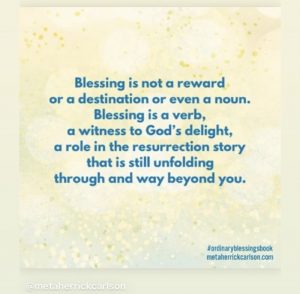
BLESSING meta carlson
I met Meta through an online book study I did last fall. She is a mom, pastor and author who lives in Minneapolis. She writes wonderful books of blessings and poetry you can find on her website
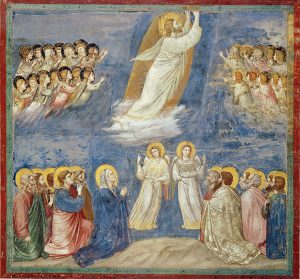
ascension by giotto
You can discover more art to pray with in a slide show below created for our Thinplace gathering this week by Teri Valente.
ART SLIDE SHOW for The Ascension created by Teri Valente
Maybe like me, you could use some blessing today. I didn’t grow up in a family that was about blessing. We had loads of material blessings but the honor and favor that Jesus bestows is not something that happened to us as kids. I need to be reminded that Jesus is all about BLESSING ME AND YOU!
“A blessing evokes a privileged intimacy. It touches that membrane where the human heart cries out to its divine ground. …A blessing is not a sentiment or a question; it is a gracious invocation where the human heart pleads with the divine heart.” John O’Donohue
Here are some words of Blessing for YOU! Which word of Blessing pops out/stands out to you that you need from Jesus now? Write it down and carry it with you today!
PEACE
INVITED TO REST
HONORED
HEIR of God
ACCEPTED
WELL PLEASED
FORGIVEN
CHOSEN
FILLED With JOY
DELIVERED
FILLED
HEALED
FRIENDSHIP /FRIEND of God
FILLED With HOPE
FREEDOM…You are set free
SATISFIED WITH GOOD THINGS
LOVED UNCONDITIONALLY
You might choose to copy the list and cut out each word/phrase, put the words in a basket and choose one each week or every couple of days to RECEIVE from God and carry with you!
How would your life be different if you lived in the BLESSING of GOD rather than in self criticism or comparison?
Who in your life needs to receive BLESSING? How can you help bless them in the days ahead?
I am reminded of the song that helped me a lot during COVID times …. May we all choose to receive the Lord’s BLESSING this week and pass it along to others! AMEN
©lillylewin and freerangeworship.com
Available as an online course, sign up here to gain 180 days of access while you work through this retreat at your own pace. Join Lilly Lewin and Christine Sine in the awe of the broad array of summer symbols that can gain spiritual significance for us when we stop and think about them. Everything from beachcombing to putting on suntan lotion can be the inspiration for practices that draw us closer to God.
Ground yourself in the earth and its summer season where you live and find the ways that God is speaking through it – all the details can be found here!
Ascension Day is today, May 26th. In the post I wrote a few years ago Ascension Day is Coming – Do You Know What it Means?, I listed a number of resources for Ascension Day. This is not a celebration I grew up with and until recently I did not know that this is not just a celebration of the ascension of Christ, it is also a celebration of the new creation that God brought into being through the ascension of Jesus. So this year I thought I would focus on Jesus as gardener of the new creation in my reflection.
I recently read Worshipping in Season: Ecology And Christ Throughout the Liturgical Year by Joseph E Bush Jr. and I was intrigued by his comment that when Christ ascended to the right hand of God he did not disconnect from the earth. In fact quite the reverse. Because God is everywhere, the right hand of God is everywhere too. When Christ ascended, Bush explains, he ascended to fill all things and to fulfill all things, reigning within creation not as some disembodied powerful ruler who stands over all creation. (p116)
The imagery of Christ as gardener is very special to me. As a keen gardener I am intrigued by the concept of Jesus as the gardener of the new creation a concept which grows more powerful for me each year as I continue to garden and reflect on the God who is revealed as I do so. I have written about the Garden Walk of Holy Week on a number of occasions, but thought that this year I would extend it to Ascension Day.
From The Drogo Sacramentary a Carolingian illuminated manuscript on vellum of c.850, vis Wikimedia Commons
Some theologians think that the whole theme of the Gospel of John is that of new creation. Most of the book of John (chapters 12-20) takes place during one week in the life of Christ. John concentrates on themes. One theme is that Christ will redeem all of Creation (not just souls) through Re-Creation. In many ways, Jesus’ death was like the planting of a seed (Unless a seed is planted in the soil and dies it remains alone, but its death will produce many new seeds, a plentiful harvest of new lives – Jn 12:24). Then in John 20:15 we read: “she thought he was the gardener” Why did it matter that Mary Magdalene thought that Jesus was the gardener? I know I have written about this before, but I wanted to summarize it again as a prelude for my litany.
In the beginning God planted a garden – the Garden of Eden (Gen 3:8). In the beginning of the new creation brought into being by the resurrection and ascension of Christ, God now in the form of the risen Christ is once more seen as a gardener. The hope and promise of these words which we so often skim over is incredible. As we read in 2 Corinthians 5:17
“Therefore if anyone is in Christ he is a new creation, the old has passed away, behold, the new has come.”
The new has come – On Good Friday Christ was planted in a garden – his mortal remains were placed in a garden tomb just as we plant seeds in the ground. On Easter Sunday we celebrate the hope that planting gave birth to. All around me seeds have sprung into life. New creation has indeed begun and we see in its birth the promise of many lives renewed, restored and bearing fruit.
A couple of years ago Good Friday and Earth Day coincided and I wrote a litany to reflect that. Then when Easter Sunday rolled around I knew I couldn’t leave it at the Cross but needed to bring the litany a step further as we celebrated Easter and the beginning of this new creation. Now I have embraced Ascension Day as well seeing the culmination of our celebration in God’s new creation and our responsibility to grow it.
Mark’s gospel is the only one that includes the story of ascension and invokes the idea of creation in the commissioning of the disciples to proclaim the gospel “to the whole creation.” We are called not just to bring healing and salvation to others but to the whole creation.
“Indeed the signs that accompany this proclamation demonstrate a resurgence of spiritual power for believers acting in Jesus name within the world of nature. In addition to speaking in tongues, these signs include casting out demons, healing the sick, being able to pick up snakes, and being able to ingest poison without harm. The power present among the believers is manifest in creation and signifies the ascended Christ’s reign in creation through these signs by believers “using my name” (Worshiping in Season Joseph E Bush Jr)
EASTER/ASCENSION DAY/CREATION LITANY
God all of created life is groaning waiting for the future you have prepared for us,
We hope for the day on which all you have made will be rescued from death and decay,
We wait for the redemption of our bodies and the restoration of our world.
In my opinion whatever we may have to go through now is less than nothing compared with the magnificent future God has planned for us. The whole creation is on tiptoe to see the wonderful sight of the sons of God coming into their own. The world of creation cannot as yet see reality, not because it chooses to be blind, but because in God’s purpose it has been so limited – yet it has been given hope. And the hope is that in the end the whole of created life will be rescued from the tyranny of change and decay, and have its share in that magnificent liberty which can only belong to the children of God!
It is plain to anyone with eyes to see that at the present time all created life groans in a sort of universal travail. And it is plain, too, that we who have a foretaste of the Spirit are in a state of painful tension, while we wait for that redemption of our bodies which will mean that at last we have realised our full sonship in him. We were saved by this hope, but in our moments of impatience let us remember that hope always means waiting for something that we haven’t yet got. But if we hope for something we cannot see, then we must settle down to wait for it in patience. (Romans 8:18 – 25 (Phillips Translation)
God in this season of hope and promise, bless the earth rich and fertile with life,
God in this season of planting and growth, bless the seed we plant and nurture,
As it falls into the ground to grow, may we remember your body broken for us.
Unless a seed is planted in the soil and dies it remains alone
But its death will produce many new seeds,
a plentiful harvest of new lives (Jn 12:24 NLT)
God as we sprinkle our gardens with the water that gives life,
May we remember earth that is parched and that is flooded,
May we remember land devastated by war and denuded by misuse.
May we remember Christ that your life blood was poured out for us,
You were hung upon a tree and crucified,
So that together with all your creation we might be liberated into freedom.
Open up O heavens and pour out your righteousness
Let the earth open wide
So salvation and righteousness can sprout up together (Is 45:8 NLT)
As we watch for the first sprouts of new creation,
We remember your resurrection promise,
A new world is being birthed with justice and peace and love,
With abundance and wholeness and healing.
Look I am making all things new…
On each side of the river grew a tree of life
Bearing twelve crops of fruit with a fresh crop each month
The leaves were used for medicine to heal the nations (Rev 21:5; 22:2 NLT)
Jesus our hope lies not in your death but in your resurrection,
Not in your dying but in your rising again,
We wait in hope for your promise to be fulfilled,
Death is conquered, resurrection has begun,
May your healing be revealed in our bodies,
May your healing power be seen throughout the earth,
May we all participate together in the coming of a new heaven and a new earth.
Mary was standing outside the tomb crying, and as she wept, she stooped and looked in. She saw two white-robed angels, one sitting at the head and the other at the foot of the place where the body of Jesus had been lying. “Dear woman, why are you crying?” the angels asked her. “Because they have taken away my Lord,” she replied, “and I don’t know where they have put him.” She turned to leave and saw someone standing there. It was Jesus, but she didn’t recognize him. 15 “Dear woman, why are you crying?” Jesus asked her. “Who are you looking for?” She thought he was the gardener. “Sir,” she said, “if you have taken him away, tell me where you have put him, and I will go and get him.” “Mary!” Jesus said. She turned to him and cried out, “Rabboni!” (which is Hebrew for “Teacher”). “Don’t cling to me,” Jesus said, “for I haven’t yet ascended to the Father. But go find my brothers and tell them, ‘I am ascending to my Father and your Father, to my God and your God.’” Mary Magdalene found the disciples and told them, “I have seen the Lord!” Then she gave them his message. (John 20:11–18 NLT)
Hallelujah, Christ is risen
You who are the gardener of the new creation,
Cultivate the new seeds that have sprung into life,
Bring growth, bring blossom, bring fruit,
May your new creation flourish in us, through us around us,
So that all the world may say together,
Christ is risen he is indeed Hallelujah.
He said to them, “Go into all the world and preach the gospel to all creation. Whoever believes and is baptized will be saved, but whoever does not believe will be condemned. And these signs will accompany those who believe: In my name they will drive out demons; they will speak in new tongues; they will pick up snakes with their hands; and when they drink deadly poison, it will not hurt them at all; they will place their hands on sick people, and they will get well.”
After the Lord Jesus had spoken to them, he was taken up into heaven and he sat at the right hand of God. Then the disciples went out and preached everywhere, and the Lord worked with them and confirmed his word by the signs that accompanied it. Mark 15:16-20 NIV
Because Jesus ascended and sits at the right hand of God,
the sprouts of new creation are growing,
And a new world has broken into ours.
A world in which justice does come for the poor,
freedom comes for the prisoners,
and healing for the sick.
Because Jesus ascended and sits at the right hand of God,
a new community has been formed –
a community that loves and cares for all members,
a family that welcomes all who are abandoned and rejected,
a place where all find a place of belonging.
Because Jesus ascended and sits at the right hand of God,
a new creation has begun –
all that was distorted is being restored,
all that is corrupted is being renewed,
all that was broken is being made whole.
Because Jesus ascended and sits at the right hand of God,
God’s new world has begun.
Amen
a perpetual astonishment.
– Ellis Peters
Explore the wonderful ways that God and God’s story are revealed through the rhythms of planting, growing, and harvesting. Spiritual insights, practical advice for organic backyard gardeners, and time for reflection will enrich and deepen faith–sign up for 180 days of access to work at your own pace and get ready for your gardening season.
by Elaine Breckenridge, featured photo: Waves at English Boom, Camano Island
During the lockdown days of the Covid-19 pandemic in 2020, personal rhythms of life were interrupted. I found myself outdoors more than ever. Instead of going out to dinner, I went out to a sunset. I staked out a pew for myself in a local state park where I worshipped with the birds and the trees. I started a blog (which never went public) and titled it, “Finding my Rhythm.”
My interest in rhythm was first awakened when I began to study Celtic Spirituality. Authors like Esther de Waal and John O’Donohue had much to say about the subject. In her book, The Celtic Way of Prayer, de Waal describes how much of Celtic Christian Spirituality was shaped by monasticism. Praying at key times of the day was not just reserved for monks in monasteries. Lay people developed their own rhythms of spirituality and punctuated the day and their chores with prayers and blessings. Some prayers were accompanied by ritual gestures. Men greeted the sun first thing in the morning by doffing their hats. Women greeted the moon by offering a generous bow. De Vaal described such rhythms of prayer and rituals as holistic, writing:
“I am reminded that as a human being living on this earth, I am a part of the pattern of day and night, darkness and light, the waxing and waning of the moon, the rising and setting of the sun. The whole of my Self is inserted into the rhythm of the elements and I can learn something of the ebb and flow of time and of life itself.”
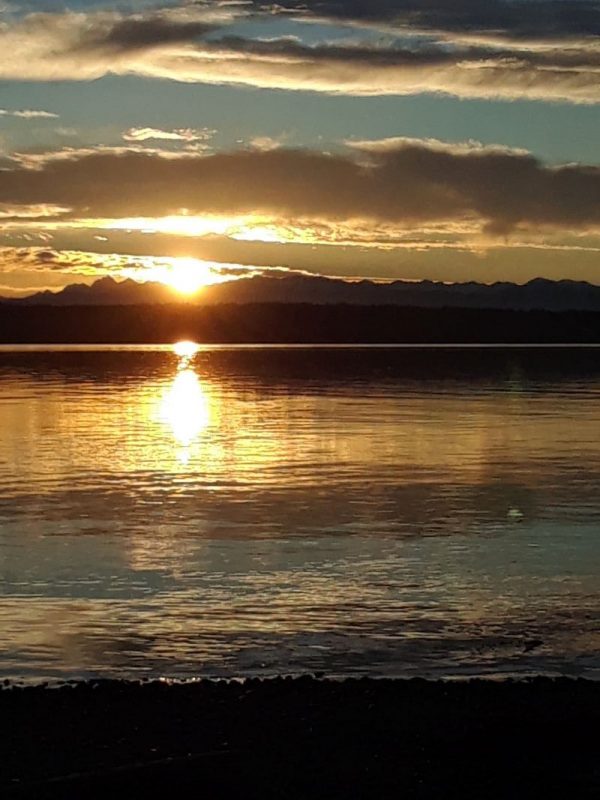
Sunset over Saratoga Passage, Camano Island
In his book, Anam Cara, O’Donohue also makes connections between nature and spirituality:
“All life came out of the ocean; each one of us comes out of the waters of the womb; the ebb and flow of the tides is alive in the ebb and flow of our breathing…To be spiritual is to be in rhythm.”
I have always been fascinated by the ebb and flow of the tides. Moving to Camano Island in Washington State has been the perfect place to practice inserting myself into their rhythm. Camano Island is visibly governed by the rhythm of tides especially at a nature preserve called English Boom, overlooking Skagit Bay. Sometimes the water laps at your feet on the beach. At other times you can barely see the water far off in the distance. These changing tides offer me guidance in my spiritual journey.
One day, I took a walk at the beach, knowing that the flood tide was going to be higher than usual. I also knew that its peak would be in thirty minutes. I walked quickly on the familiar trail. I reached the end of the trail and was exhilarated to see the fast-moving currents. Immediately I headed back the way I came. Oops! I had miscalculated the reality of both the height and speed of the high tide. As I approached my bridge to gain access to the end of trail, I saw the flood tide had washed over a section of the bridge.
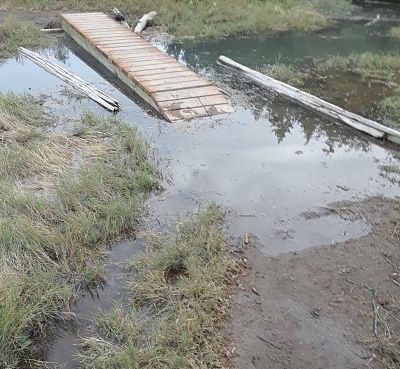
Washed out Bridge, English Boom Nature Preserve
There was no going around it, only going through it. As I stepped off the bridge, I was surprised how far I sank. The water was past my knees! Perhaps had I lingered longer at the end of the trail, I might have found myself up to my waist and forced to swim!
What I learned from the incident of being up to my knees in water is that living my own rhythm often involves trial and error. The rhythm of my life has changed significantly since I retired from full-time parish ministry and I am still experimenting. The ebb and flow between grandparenting, now working part-time, attending to old projects and developing new interests is sometimes chaotic. I have at times over-focused on one of these aspects and found myself “in the deep end” and have been frustrated with my choices.
I had always favored visiting the preserve when it was near high tide. But one day I visited the beach when the tide was at its lowest point. What a revelation! So often I had looked up at the sky and out at the rolling waves. On this day I looked down to the ground and in between the rocks and discovered that the Earth was teeming with life. What the tide had brought in was magnificent!
Seeing the landscape in this new light, I began to think about my own inner landscape. It made me realize how much I craved excitement like the rolling high tide. I began to see the value in slowing down and enjoying my energy when it is at its ebb. It has given me courage to explore my shadow. What might be hidden between the rocks and the hard places of my life? I am discovering new life in surprising places.
In Anam Cara, O’Donohue has also written, “There is a unique destiny for each person. Each of us has something to do here that can be done by no one else. If you can awaken this kind of destiny, you come into rhythm with your life.”
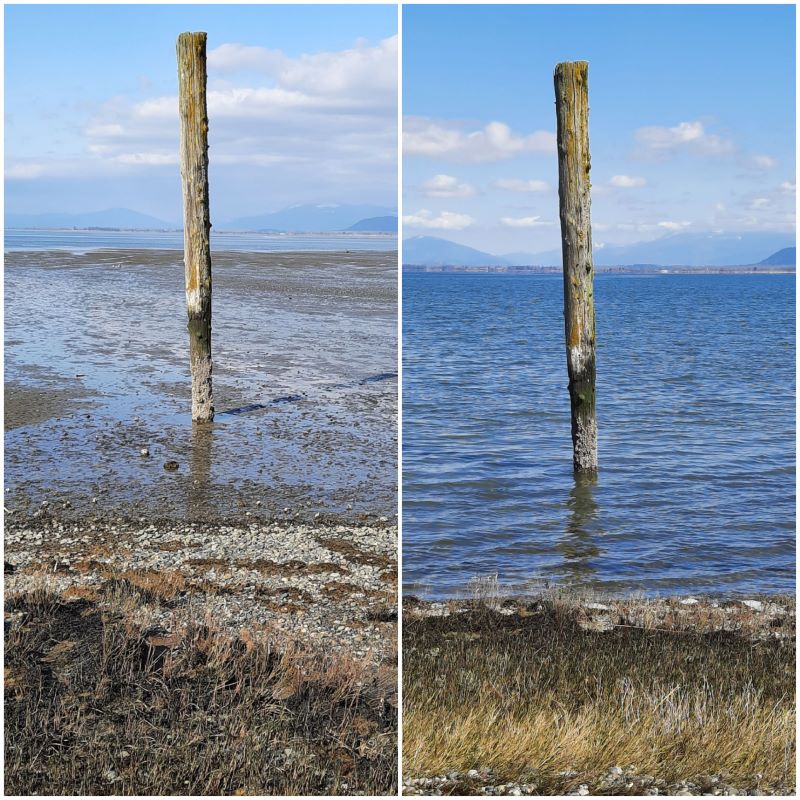
Low tide/High tide at English Boom Nature Preserve
Following the tides is helping me to accept and celebrate that I have my own unique rhythm and it is all good. It is my nature to swell and recede and it is time to enjoy it!
“Finding my rhythm?” I don’t think so. If I ever do launch that blog, I will need to give it another name. Today, I bow to the Gershwin brothers as I claim, “I got rhythm! Who could ask for anything more?”
* * *
As an Amazon Associate I receive a small amount for purchases made through appropriate links. Thank you for supporting Godspace in this way.
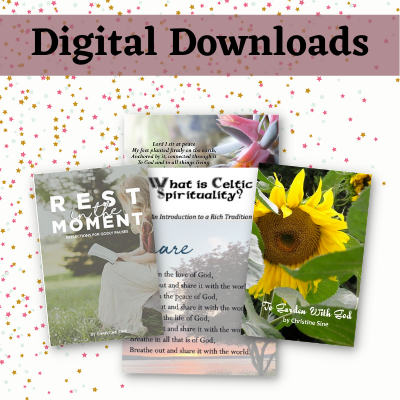 Did you know? We have many resources available for downloads–from books to retreats, cards and coloring pages, and much more–including free resources! Check out our shop here for all the fun!
Did you know? We have many resources available for downloads–from books to retreats, cards and coloring pages, and much more–including free resources! Check out our shop here for all the fun!
writing and pictures by June Friesen
Birds bring me encouragement and joy. When I find myself discouraged and struggling with personal issues and/or troubled by the events around me or the world I often think of the birds. I am so fascinated by their complete trust in their Creator. There is nothing more calming to me that a dove – their calm cooing, their quiet manner of just sitting and quietly watching. This is very possibly the result of what I call my friendship with a dove.
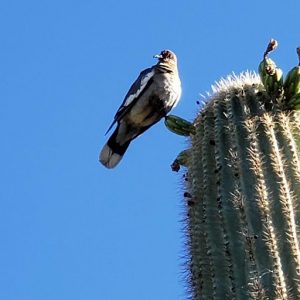
When I was a young girl of about twelve the farm my family lived on had many evergreen pines on it. There was a worn path through two of them because it was a direct route to the mailbox. In spring I noticed a bird fly from a rather low branch. I stopped and looked a bit closer and there was a flimsily built nest with three eggs lying in it. I tried my best when I went by not to disturb her too much and often, she just sat and watched me walk by. I waited patiently wondering. I kept checking when she was not on the nest to watch for progress … and then one day two eggs were hatched and the next day all three were hatched. I monitored the happenings over the next few weeks and then one day the nest was empty – they had grown enough to fly on their own. To my amazement and delight, this dove returned for several years granting me the opportunity to watch her raise her little family each year.
This story reminds me of how much God loves and cares for the birds – and the Scriptures remind us that with that kind of care for the birds His care for you and I is even greater. And so as I struggle with the events of our world and often find my spirit restless I think back to how God cared for this dove and her families – as well as all birds. Yet the Scriptures also remind us that God cares for us even more.
PSALM 55 (select verses) The Message Translation
55 1-3 Open your ears, God, to my prayer; don’t pretend you don’t hear me knocking.
Come close and whisper your answer. I really need you.
I shudder at the mean voice, quail before the evil eye,
As they pile on the guilt, stockpile angry slander.4-8 My insides are turned inside out; specters of death have me down.
I shake with fear, I shudder from head to foot.
“Who will give me wings,” I ask— “wings like a dove?”
Get me out of here on dove wings; I want some peace and quiet.
I want a walk in the country, I want a cabin in the woods.
I’m desperate for a change from rage and stormy weather.9-11 Come down hard, Lord—………..
I’m appalled how they’ve split the city into rival gangs prowling the alleys
Day and night spoiling for a fight, trash piled in the streets,
Even shopkeepers gouging and cheating in broad daylight……..16-19 I call to God; God will help me.
At dusk, dawn, and noon I sigh deep sighs—he hears, he rescues.
My life is well and whole, secure in the middle of danger
Even while thousands are lined up against me.
God hears it all, and from his judge’s bench puts them in their place.
But, set in their ways, they won’t change; they pay him no mind…….22-23 Pile your troubles on God’s shoulders— he’ll carry your load, he’ll help you out.
He’ll never let good people topple into ruin……..And I trust in you.
The Scriptures invite us to call out to God in these struggles. There are times when I have my window open at night and hear the sounds of the city. At times there are people talking, laughing, and also disagreeing. Sometimes there are disturbing sounds of racing motors, thumps, etc. and I find myself praying for anyone who may be struggling with issues, not knowing how to cope or where to turn. I am learning that like the birds of His creation God desires that I not only care for myself and my immediate family or even just my friends and/or church family – God is looking for prayer warriors everywhere. It does not matter where one is, who one is, what color one is, or what language one speaks – when one is prompted by the Spirit to pray – it is important to be obedient. As I have chosen to practice taking the present moment of prompting to pray, I have found my spirit more at peace and I have also found that it seems to bring more rest in the neighborhood around me. All of us live in different communities, some in the city, village or country, some in houses, some in apartments, some in trailers and sadly some do not have a place to really call home, yet all of us can pray.
PRAYER: RESTING WITH GOD
Father – You have invited us to talk to You,
You have encouraged us by the example of Your Son,
You have given us instructions on how to pray at certain times,
You have even told us when we have no words – You understand our groans.
Father – I remember the times when my heart has literally been breaking –
Someone is facing a tragedy, an unexpected illness or death,
A loved one or they themself have lost their home, their job, or mobility,
Someone is so broken in spirit they seem without hope …
God thank you for hearing the painful cries and groans of my spirit
And giving me strength to walk with my friend as You walk with me.
Father – I desire for my friends, family as well as all who read this today
To be encouraged to take the time to trust You with their lives
As the birds do, particularly my friend the dove,
Please give them a restful, calming in their spirit today
And they too will know that they have been carried upwards
Into Your ever-loving presence not only for this moment
But it is something they can embrace 24/7 –
Because ‘You, O God, are only a prayer away.
Amen and amen.
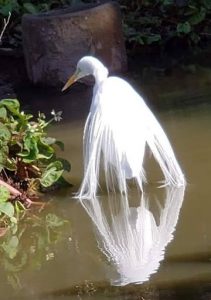
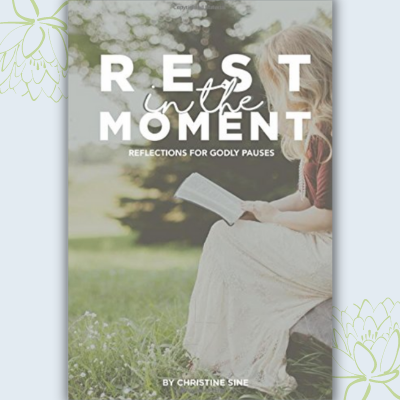 The twelve meditations in this beautiful full-color book are designed to provide moments of refreshment throughout the day or week. The blending together of prayers, reflections, questions, and photos invites us to pause, reset and refresh ourselves. Rest is such an important part of the rhythm of our lives, not just a weekly rest of Sabbath, but pauses of rest throughout the day to reset our focus and renew our connections to God. Enjoy as a PDF download, or purchase the hard copy here.
The twelve meditations in this beautiful full-color book are designed to provide moments of refreshment throughout the day or week. The blending together of prayers, reflections, questions, and photos invites us to pause, reset and refresh ourselves. Rest is such an important part of the rhythm of our lives, not just a weekly rest of Sabbath, but pauses of rest throughout the day to reset our focus and renew our connections to God. Enjoy as a PDF download, or purchase the hard copy here.
This morning I sat down to write my Meditation Monday and my mind went blank. I had no idea of what my intended topic was. It’s something that happens to all of us so I thought I should treat it as though it were a gift from God rather than a liability. Which made me realize that the best place to start my morning was by exercising the parts of my brain that were still functioning properly and do a little research on “blank mind syndrome.” I am sure most of you are not interested in the parts of the brain involved as they all have big names like hypocanthus and hypothalamus, but you might be interested in some of the causes and what we can do to overcome it.
The most common causes of blank mind are anxiety, lack of sleep, medication, change and feeling overwhelmed. This morning I knew my lack of sleep was the culprit. My dog decided to vomit in the middle of the night and then cough her way through until the morning. Of course Tom slept through the whole thing and but I kept worrying about whether or not she was sick enough to take to an emergency vet. She wasn’t, but by the time I realized that, the whole night had passed.
Occasional mind blankness like this is not something to be afraid or ashamed of. In fact, according to Janis Leslie Evans in What is Mind Blanking? Tips to Get Rid of that Foggy Feeling.it helps to share our problem with others, laugh at ourselves and reset our goals, which is exactly what I decided to do this morning. I’m relishing my blank mind because it has led me into a new area of research, and taught me some new fun facts. It really is a gift and not a liability.
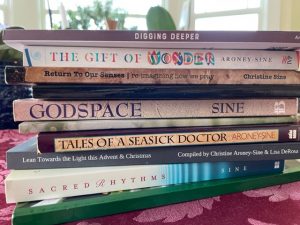
Evidently revisiting a sample of what we wrote or created in the past to remind ourselves of how productive we have been and can be again is helpful. “You are the same person with the same skills” What a great idea I thought. How rarely we remind ourselves of what we have accomplished and applaud ourselves for our productivity. So I picked up The Gift of Wonder intending to read some of my favourite portions and exercises but I didn’t get past the first chapter. “What do I enjoy doing that makes me sense God’s pleasure?” I wrote and I realized that was God’s word for me again today. God takes delight in us and what we accomplish and I don’t know about you, but I rarely take time to acknowledge that. So I stacked up the books I have written and thanked God for them. I looked through some of my prayer cards, and admired my Digging Deeper garden which still sits on my desk. Finally I hurried out to the front porch where some of my warm weather seedlings are still waiting for warmer weather before they can go outside. My basil needed pinching out so that the plants will bush out and give us a generous crop of basil. I took great delight in completing that task and walked back to my desk with the wonderful aroma of basil clinging to my clothes.
When blank brain sets in do some deep breathing exercises, center your attention outside of yourself. Take notice of your environment with the help of your senses Evans suggests so now I sit breathing slowly in and out aware of the fragrance of God, all around me. It clings to us at all times yet we rarely pause to notice. Now as I breathe, that wonderful fragrance relaxes me, I collect my thoughts and allow my memory to do its job.
So when blank brain sets in, take some deep breaths and allow the spirit of God to guide you. Like me I am sure you will be able to say “Wow, I think this might be what God wanted me to write about after all.”
 It’s here! Christine Sine’s new book is now ready for purchase! Journey along with Christine as she walks you through contemplative container gardening. Reviews are coming in:
It’s here! Christine Sine’s new book is now ready for purchase! Journey along with Christine as she walks you through contemplative container gardening. Reviews are coming in:
“This book invites and inspires everyone, regardless of skill or experience, to create expressions of the sacred through the media of soil, stones, and plants.” – Forrest Inslee, host of Earthkeepers Podcast
As an Amazon Associate, I receive a small amount for purchases made through appropriate links.
Thank you for supporting Godspace in this way.
When referencing or quoting Godspace Light, please be sure to include the Author (Christine Sine unless otherwise noted), the Title of the article or resource, the Source link where appropriate, and ©Godspacelight.com. Thank you!

